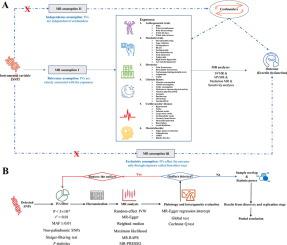当前位置:
X-MOL 学术
›
J. Adv. Res.
›
论文详情
Our official English website, www.x-mol.net, welcomes your feedback! (Note: you will need to create a separate account there.)
Insights into modifiable risk factors of erectile dysfunction, a wide-angled Mendelian Randomization study
Journal of Advanced Research ( IF 10.7 ) Pub Date : 2023-05-25 , DOI: 10.1016/j.jare.2023.05.008 Yang Xiong 1 , Fuxun Zhang 1 , Yangchang Zhang 2 , Wei Wang 1 , Yuxin Ran 3 , Changjing Wu 4 , Shiyu Zhu 1 , Feng Qin 4 , Jiuhong Yuan 1
Journal of Advanced Research ( IF 10.7 ) Pub Date : 2023-05-25 , DOI: 10.1016/j.jare.2023.05.008 Yang Xiong 1 , Fuxun Zhang 1 , Yangchang Zhang 2 , Wei Wang 1 , Yuxin Ran 3 , Changjing Wu 4 , Shiyu Zhu 1 , Feng Qin 4 , Jiuhong Yuan 1
Affiliation

|
The causal association between modifiable risk factors and erectile dysfunction (ED) remains unclear, which hinders the early identification and intervention of patients with ED. The present study aimed to clarify the causal association between 42 predominant risk factors and ED. Univariate Mendelian Randomization (MR), multivariate MR, and mediation MR analyses were used to investigate the causal association between 42 modifiable risk factors and ED. Combined results were pooled from two independent ED genome-wide association studies to verify the findings. Genetically predicted body mass index (BMI), waist circumference, trunk fat mass, whole body fat mass, poor overall health rating, type 2 diabetes, basal metabolic rate, adiponectin, cigarette consumption, insomnia, snoring, hypertension, stroke, ischemic stroke, coronary heart disease, myocardial infarction, heart failure, and major depressive disorder were found to increase the risk of ED (all < 0.05). Additionally, genetic liability to higher body fat percentage and alcohol consumption were suggestively associated with an increased risk of ED ( < 0.05 and adjusted > 0.05). Genetic predisposition to higher sex hormone-binding globulin (SHBG) levels could decrease the risk of ED ( < 0.05). No significant association was detected between lipid levels and ED. Multivariate MR identified type 2 diabetes, basal metabolic rate, cigarette consumption, hypertension, and coronary heart disease as risk factors for ED. The combined results confirmed that waist circumference, whole body fat mass, poor overall health rating, type 2 diabetes, basal metabolic rate, adiponectin, cigarette consumption, snoring, hypertension, ischemic stroke, coronary heart disease, myocardial infarction, heart failure, and major depressive disorder could increase the risk of ED (all < 0.05), while higher SHBG decreased the risk of ED ( = 0.004). There were suggestive significances of BMI, insomnia, and stroke on ED ( < 0.05 and adjusted > 0.05). This comprehensive MR study supported the causal role of obesity, type 2 diabetes, basal metabolic rate, poor self-health rating, cigarette and alcohol consumption, insomnia and snoring, depression, hypertension, stroke, ischemic stroke, coronary heart disease, myocardial infarction, heart failure, SHBG, and adiponectin in the onset and development of ED.
中文翻译:

洞察勃起功能障碍的可改变危险因素,广角孟德尔随机研究
可改变的危险因素与勃起功能障碍 (ED) 之间的因果关系仍不清楚,这阻碍了 ED 患者的早期识别和干预。本研究旨在阐明 42 个主要危险因素与 ED 之间的因果关系。使用单变量孟德尔随机化 (MR)、多变量 MR 和中介 MR 分析来调查 42 个可改变的危险因素与 ED 之间的因果关系。两项独立的 ED 全基因组关联研究合并结果以验证研究结果。基因预测体重指数(BMI)、腰围、躯干脂肪量、全身脂肪量、整体健康状况不佳、2型糖尿病、基础代谢率、脂联素、吸烟量、失眠、打鼾、高血压、中风、缺血性中风、冠心病、心肌梗塞、心力衰竭和重度抑郁症被发现会增加 ED 的风险(均 < 0.05)。此外,较高体脂百分比和饮酒的遗传倾向与 ED 风险增加相关(< 0.05 且调整后 > 0.05)。性激素结合球蛋白 (SHBG) 水平较高的遗传倾向可以降低 ED 的风险 (< 0.05)。血脂水平与 ED 之间未发现显着关联。多变量 MR 确定 2 型糖尿病、基础代谢率、吸烟、高血压和冠心病是 ED 的危险因素。综合结果证实,腰围、全身脂肪量、整体健康状况不佳、2型糖尿病、基础代谢率、脂联素、吸烟、打鼾、高血压、缺血性中风、冠心病、心肌梗塞、心力衰竭和重大疾病抑郁症可能会增加 ED 的风险(均 < 0.05),而较高的 SHBG 会降低 ED 的风险(= 0.004)。 BMI、失眠和中风对 ED 具有提示意义(< 0.05 且调整后 > 0.05)。这项全面的MR研究支持了肥胖、2型糖尿病、基础代谢率、自我健康评级差、吸烟和饮酒、失眠和打鼾、抑郁、高血压、中风、缺血性中风、冠心病、心肌梗塞、心力衰竭、性激素结合球蛋白 (SHBG) 和脂联素在 ED 发生和发展中的作用。
更新日期:2023-05-25
中文翻译:

洞察勃起功能障碍的可改变危险因素,广角孟德尔随机研究
可改变的危险因素与勃起功能障碍 (ED) 之间的因果关系仍不清楚,这阻碍了 ED 患者的早期识别和干预。本研究旨在阐明 42 个主要危险因素与 ED 之间的因果关系。使用单变量孟德尔随机化 (MR)、多变量 MR 和中介 MR 分析来调查 42 个可改变的危险因素与 ED 之间的因果关系。两项独立的 ED 全基因组关联研究合并结果以验证研究结果。基因预测体重指数(BMI)、腰围、躯干脂肪量、全身脂肪量、整体健康状况不佳、2型糖尿病、基础代谢率、脂联素、吸烟量、失眠、打鼾、高血压、中风、缺血性中风、冠心病、心肌梗塞、心力衰竭和重度抑郁症被发现会增加 ED 的风险(均 < 0.05)。此外,较高体脂百分比和饮酒的遗传倾向与 ED 风险增加相关(< 0.05 且调整后 > 0.05)。性激素结合球蛋白 (SHBG) 水平较高的遗传倾向可以降低 ED 的风险 (< 0.05)。血脂水平与 ED 之间未发现显着关联。多变量 MR 确定 2 型糖尿病、基础代谢率、吸烟、高血压和冠心病是 ED 的危险因素。综合结果证实,腰围、全身脂肪量、整体健康状况不佳、2型糖尿病、基础代谢率、脂联素、吸烟、打鼾、高血压、缺血性中风、冠心病、心肌梗塞、心力衰竭和重大疾病抑郁症可能会增加 ED 的风险(均 < 0.05),而较高的 SHBG 会降低 ED 的风险(= 0.004)。 BMI、失眠和中风对 ED 具有提示意义(< 0.05 且调整后 > 0.05)。这项全面的MR研究支持了肥胖、2型糖尿病、基础代谢率、自我健康评级差、吸烟和饮酒、失眠和打鼾、抑郁、高血压、中风、缺血性中风、冠心病、心肌梗塞、心力衰竭、性激素结合球蛋白 (SHBG) 和脂联素在 ED 发生和发展中的作用。


























 京公网安备 11010802027423号
京公网安备 11010802027423号